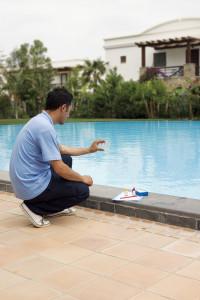How are phosphates controlled?
The first and easiest step in controlling phosphate levels is to limit the amount of phosphates that are introduced to the pool. This can be accomplished by covering the pool when nearby lawns or golf courses are being treated and during high winds when organic debris can be easily blown into the water. It is also a good idea to keep the pool covered as often as possible during high pollen count seasons and when trees and plants have seeds, leaves and blossoms blowing around. Should any organic matter enter the pool, ensure it is removed before it has a chance to decay and release unwanted phosphates. Also, encourage pool owners to shower before entering their pool area and suggest the idea of keeping a poolside wash station where they can rinse their dirty feet before re-entering the pool.

The next step is water treatment. As mentioned earlier, maintaining proper chlorine (Cl) levels, along with a balanced pH and alkalinity (AT), will usually prevent algae outbreaks from occurring. However, there are bound to be seasons when this does not go according to plan. When this happens, phosphate removal chemicals can be used to help prevent an algae outbreak—even if is challenging to control the other water parameters for a short time.
Phosphate removal chemicals are typically based on a lanthanum (a rare earth element) compound, although some newer technology is emerging. When added to the pool, these compounds react with phosphates in the water and precipitate them from solution. At this point, they can be effectively removed from the water via filtration or vacuuming.
Phosphate removal treatments in the spring and fall are also a good idea if phosphate levels were problematic throughout the year. A spring start-up dose is recommended if leaves and other debris have been sitting in the pool, decaying throughout the winter or if algae is present.
This treatment may cause temporary water cloudiness as the phosphate reacts with the lanthanum to form a precipitate that can be filtered out. It may also occur in pockets of stagnant water, which may need to be vacuumed to be removed.
Routine application reduces outbreaks
Controlling phosphate levels in this manner can help prevent algae outbreaks when water chemistry is not ideal. However, if a particular pool continues to have recurring algae problems, a regular dose of phosphate removal will help prevent, or at least reduce, the number of outbreaks.
Most phosphate removal product manufacturers recommend a weekly dosage to help maintain low phosphate levels when the phosphate source is hard to identify or impossible to keep out (e.g. family pet). This routine also helps to support sanitizer levels in swimming pools that tend to be poorly maintained.
With the understanding that phosphates will more than likely always be present in swimming pool water, it is important to take the necessary steps to limit the amount of phosphate that enters the pool and to treat any outbreaks in a timely fashion.
Pool owners do not have to forego a green lawn to keep their swimming pool clean. If the right course of action is followed, they should have no problems controlling the phosphate levels in their pools.
 Joe Sweazy is technical sales and services manager for HACH Company/ETS Business Unit, manufacturer of AquaChek® pool and spa test strips, TruTest® digital test strip reader, FastChek™ Pro prescription testing system and other water quality products. He has published dozens of articles on pool and spa water chemistry and has presented numerous seminars at conferences of the Association of Pool & Spa Professionals (APSP), Northeast Spa & Pool Association (NESPA) and the World Aquatic Health™ Conference (WAHC). He can be reached via e-mail at jsweazy@hach.com.
Joe Sweazy is technical sales and services manager for HACH Company/ETS Business Unit, manufacturer of AquaChek® pool and spa test strips, TruTest® digital test strip reader, FastChek™ Pro prescription testing system and other water quality products. He has published dozens of articles on pool and spa water chemistry and has presented numerous seminars at conferences of the Association of Pool & Spa Professionals (APSP), Northeast Spa & Pool Association (NESPA) and the World Aquatic Health™ Conference (WAHC). He can be reached via e-mail at jsweazy@hach.com.







